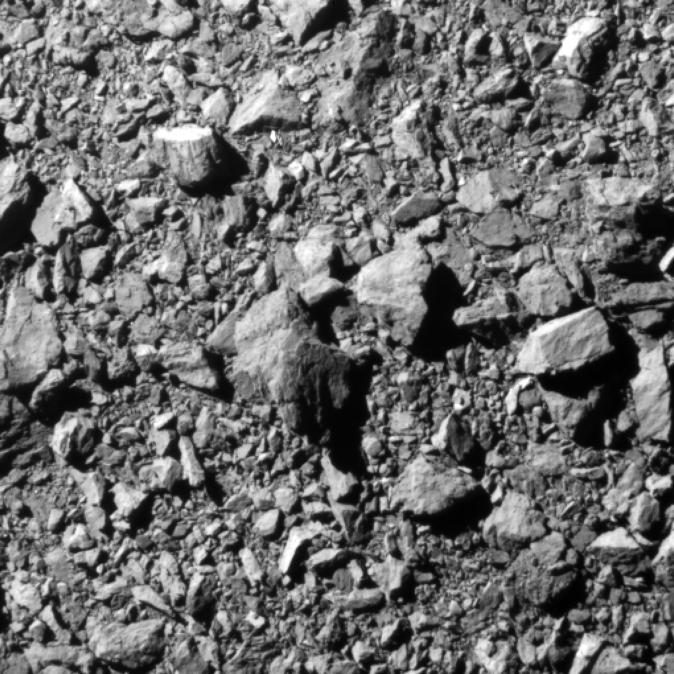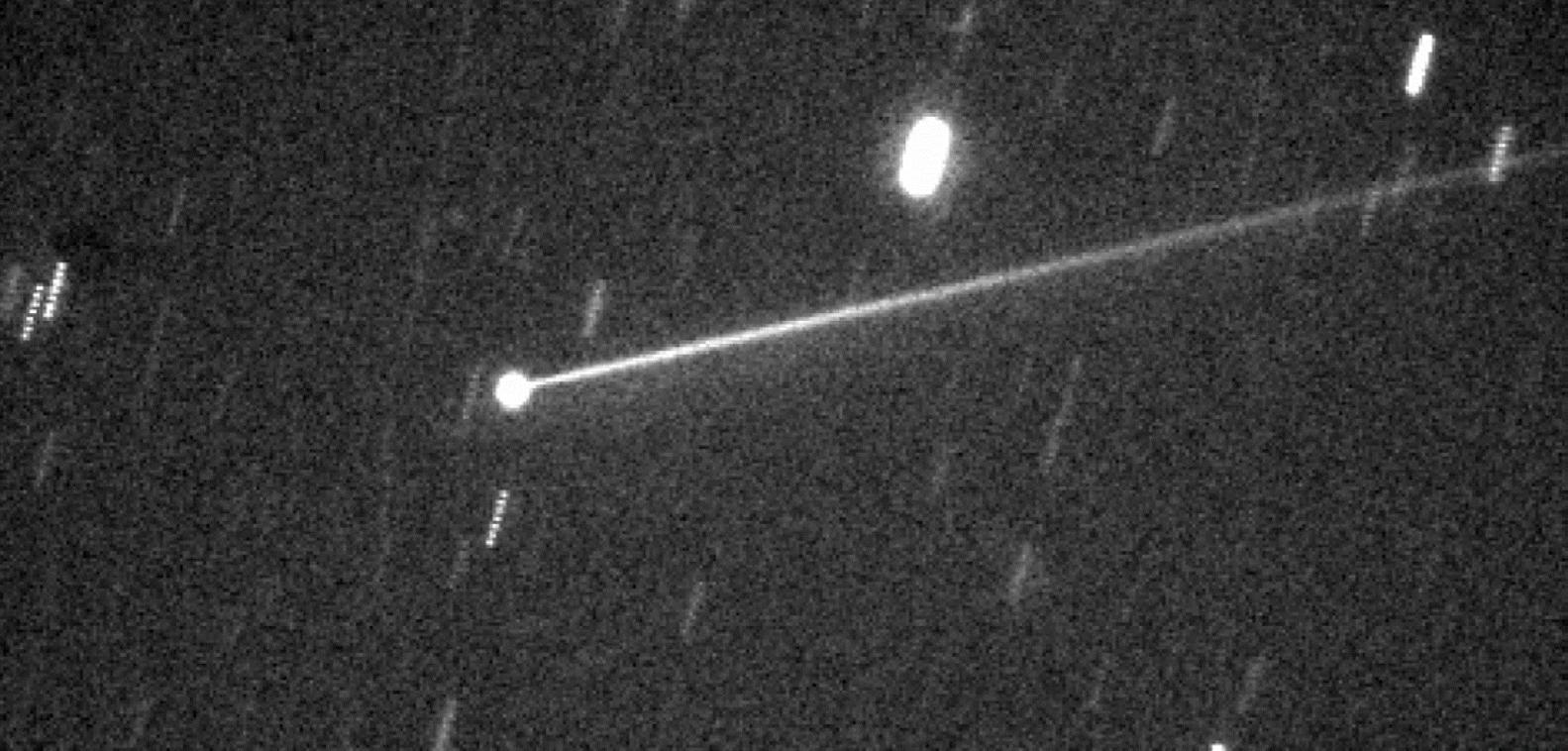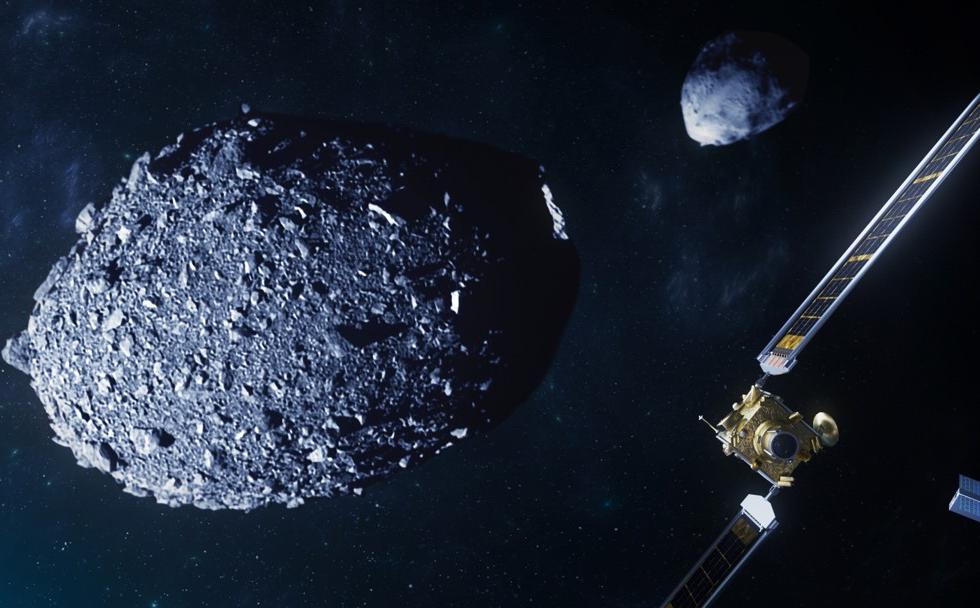
9 minute read
Research Highlight
Ongoing Efforts of the International DART Investigation Team to Understand Humanity’s First Asteroid Deflection Mission
[Nancy L. Chabot, Andrew S. Rivkin, Andrew F. Cheng Johns Hopkins University Applied Physics Laboratory, USA]
‘‘One of DART’s primary requirements was for DART’s kinetic impact to cause at least a 73 s orbital period change for Dimorphos’’
On 26 September 2022, NASA’s Double Asteroid Redirection Test (DART) spacecraft successfully collided with the asteroid Dimorphos [1], making history as humanity’s first demonstration of asteroid deflection. Shared live via a NASA broadcast, over a million concurrent viewers around the world watched as the DART spacecraft streamed images to Earth up to the final second before its impact with Dimorphos (Fig. 1). Autonomously targeting a small asteroid with limited prior knowledge at high speed was a key accomplishment for the DART mission and one of the mission’s primary requirements [2]
While the inflight operations of the DART spacecraft ended on 26 September 2022, other aspects of the DART project and its planetary defence mission were just beginning. Additional primary mission requirements remained to be completed by the DART project, and the international DART Investigation Team got quickly to work to begin to address them.
Measuring the Amount of Deflection
A key aspect of the DART mission concept was to change the orbital period of Dimorphos around Didymos by an amount that could be clearly measured using Earth-based telescopes (Fig. 2). The Didymos-Dimorphos double asteroid system and DART’s impact date during fall of 2022 were chosen for these reasons. Telescopes had measured the orbital period of Dimorphos very precisely prior to DART’s impact [3–5], and on 26 September 2022, the Didymos asteroid system was 11 million km from Earth, allowing the telescopes to get high-quality data at the time of DART’s impact. Didymos remained well positioned for Earth-based observations for many months afterwards, enabling an extended period of measurements. One of DART’s primary requirements was for DART’s kinetic impact to cause at least a 73 s orbital period change for Dimorphos, which was judged to be the minimum that could be confidently detected by the telescopic observations with a 10% accuracy during the observing period [2].
During a NASA press conference on 11 October 2022, the DART team announced the initial result that the binary orbit period of Dimorphos had been reduced by 32 minutes with an uncertainty of ±2 minutes, greatly surpassing this primary requirement. Both photometric observations by ground-based optical telescopes and planetary radar observations contributed to determining the post-impact binary orbital period of Dimorphos. Additional observations in October 2022 refined the orbital period change to be –33.0 ±1.0 (3’) minutes [6]. Telescopic observations have continued beyond this initial dataset and will continue through March 2023. These measurements are refining the accuracy of the period change measurement and contributing to understanding the dynamical effects to the Didymos-Dimorphos system by DART’s impact event.
Determining the Momentum Transfer Enhancement Factor
DART was the first full-scale demonstration of the kinetic impactor technique for asteroid deflection, and a strong motivation for the full-scale test was to learn how an actual asteroid of the relevant size would react to DART’s collision. At 150 meters in diameter, Dimorphos is the size for which a kinetic impactor has been considered as a possible mitigation
‘‘significantly more momentum was transferred to Dimorphos from the escaping impact ejecta than was incident with the DART spacecraft’’ technique. Hence a DART primary requirement was for the team to determine ß, the momentum transfer enhancement factor, a measure of how much the asteroid was deflected relative to the momentum brought in by the DART spacecraft during its collision.
Using the sizes and shapes of Didymos and Dimorphos determined from DART’s approach imaging (Fig. 3) to estimate the mass of Dimorphos [2] and the orbital period change determined from telescopic observations [6], an initial assessment of ß yielded a range of values from 2.4 to 4.9 [7]. The large range in ß values is due to the uncertainty in the bulk density of Dimorphos, as the mass of Dimorphos was not measured by the DART mission. If Dimorphos is assumed to have the same density as Didymos of 2,400 kg/m3, then the resulting ß value is 3.6 [7]. These ß values are within the range of pre-impact predictions [8] and indicate that significantly more momentum was transferred to Dimorphos from the escaping impact ejecta than was incident with the DART spacecraft. This is an exciting and promising result for planetary defence, indicating that a kinetic impactor technique may be an efficient method to protect Earth from asteroid impacts in the future.
The DART Investigation Team is continuing in its analysis efforts to further refine and understand the ß value produced by DART’s kinetic impact. In particular, including more detailed modelling and analysis of the ejecta produced by the impact as observed by space-based [9] and ground-based telescopes as well as by the Light Italian CubeSat for Imaging of Asteroids (LICIACube), contributed by the Italian Space Agency (Agenzia Spaziale Italiana, ASI) [10], can provide further insight into the ß value, as can simulations of DART’s kinetic impact event. Such analyses are ongoing within the DART Investigation Team.
Understanding DART’s Test to Inform Future Planetary Defence Efforts
As stated in the mission’s name, DART was just a test. Neither Dimorphos nor Didymos poses any hazard to Earth either before or after DART’s collision. Rather, this double asteroid system served as the ideal target for humanity’s first planetary defence test mission. The DART Investigation Team has been working to not just measure what DART’s impact did to Dimorphos but, more importantly, to fully understand the results so they can be used to inform future planetary defence efforts. The DART Investigation Team is actively working on a range of activities to accomplish this broad primary requirement.
Numerous ground-based and space-based facilities have been engaged in the team’s observing campaign (Fig. 4). Telescopic facilities on all seven continents have made measurements of the post-impact Didymos system in support of the DART project, as have the Hubble Space Telescope, JWST, and Lucy projects. Along with determining the orbital period change of Dimorphos, telescopic observations have been characterizing the properties of the Didymos system, and observations of the ejecta evolution produced by DART’s impact are currently ongoing (Fig. 5). Analysis of the many months of telescopic data is yielding insights into the properties of the ejecta and its evolution, with initial estimates placing the total mass of ejecta at more than a million kg.
Images obtained by ASI’s LICIACube CubeSat capture in spectacular detail the ejecta resulting from DART’s kinetic impact into Dimorphos (Fig. 6). LICIACube was carried by DART until 15 days prior to DART’s impact, at which time it was deployed and operated independently to witness DART’s impact. LICIACube made its closest flyby of Dimorphos about 3 minutes after DART’s impact at a distance of roughly 58 km, acquiring images of Dimorphos and the evolving ejecta both before and after its closest approach. Analysis of the LICIACube images is ongoing, and the images are being used to study the surfaces of both asteroids as well as the characteristics of the ejecta and its complex morphology.
IAdditionally, work is in progress to understand the geology and surface characteristics of the impact site. Studies to model the ejecta formation and evolution, DART’s kinetic impact event, and the dynamics of the Didymos system are also underway.
‘‘Telescopic facilities on all seven continents have made measurements of the post-impact Didymos system’’
All of these current efforts will contribute to a full understanding of DART’s first demonstration of asteroid deflection to inform future planetary defence applications.
International Collaboration for an International Issue
The DART Investigation Team includes roughly 300 scientists from over 100 different institutions that represent 28 different countries, supporting international cooperation for the international issue of planetary defence. The DART Investigation Team will continue their work through the end of NASA’s DART project in September 2023. DART’s pioneering planetary defence mission is followed by ESA’s Hera mission [11] (Fig. 7), and the DART and Hera teams have worked closely throughout the development of the two missions. Planned for launch in 2024, Hera will rendezvous with the Didymos system in late 2026 and conduct a robust remote sensing campaign in 2027, including determining the mass of Dimorphos as a crucial measurement to better understand the ß value from DART’s kinetic impact. The combined efforts of the DART and Hera missions will provide fundamental insight into understanding the kinetic impactor technique as a potential method of asteroid deflection, taking the first steps to develop a capability to potentially prevent an asteroid impact with the Earth in the future, if such a need should arise.

Acknowledgments:
Johns Hopkins APL built and operated the DART spacecraft and manages the DART mission for NASA’s Planetary Defense Coordination Office as a project of the agency’s Planetary Missions Program Office. This work was supported by the DART mission, NASA Contract 80MSFC20D0004, and by the Italian Space Agency (ASI) within the LICIACube project (ASI-INAF agreement AC n. 2019-31-HH.0).
References:
1. Daly, R. T. et al. (2023) Nature, in press.
2. Rivkin, A. S. et al. (2021) Planet. Sci. J. 2 173, doi: 10.3847/PSJ/ac063e.
3. Pravec, P. et al. (2022) Planet. Sci. J. 3 175, doi: 10.3847/PSJ/ac7be1.
4. Scheirich, P. and Pravec, P. (2022) Planet. Sci. J. 3 163, doi: 10.3847/PSJ/ac7233
5. Naidu, S. P. et al. (2022) Planet. Sci. J. 3 234, doi: 10.3847/PSJ/ac91c0
6. Thomas, C. A. et al. (2023) Nature, in press.
7. Cheng, A. F. et al. (2023) Nature, in press.
8. Stickle, A. M. et al. (2022) Planet. Sci. J. 3 248, doi: 10.3847/PSJ/ac91cc.
9. Li J.-Y. et al (2023) Nature, in press.
10. Dotto, E. et al. (2021) Planet. Space Sci. 1999, 105185. doi: 10.1016/j.pss.2021.105185
11. Michel, P. et al. (2022) Planet. Sci. J. 3 160, doi: 10.3847/PSJ/ac6f52
Fig. 1. The last complete image of asteroid moonlet Dimorphos, taken by the DART spacecraft. The image shows a patch of the asteroid that is 100 feet (31 meters) across, and Dimorphos’ north is toward the top of the image. (Image credit: NASA/Johns Hopkins APL).


Fig 2. Illustration of the effect of DART’s impact on the orbit of Dimorphos. (Image credit: NASA/Johns Hopkins APL).
Fig. 3. Views of the asteroids 150-meter Dimorphos (left) and 760-meter Didymos (right), oriented with their rotational north poles toward the top of the image and with each asteroid and their distance to each other to scale; this product was produced by compiling two images taken by DART. (Image credit : NASA/Johns Hopkins APL).
Fig. 4. Over three dozen telescopic facilities in space and around the globe observed the Didymos asteroid system in support of DART’s global observation campaign after impact. Numerical figures in parentheses next to telescope names indicate the telescope size. (Image credit: NASA/Johns Hopkins APL/Nancy Chabot/Mike Halstad).
Fig. 5. An image of the Didymos system constructed from several images taken on 30 November 2022 by astronomers at Magdalena Ridge Observatory in New Mexico, USA. This image is roughly 32,000 km across the field of view at the distance of Didymos. (Image credit: Magdalena Ridge Observatory/NM Tech).
Fig. 6. LICIACube acquired this image just before its closest approach to Dimorphos, at 156 seconds after DART’s kinetic impact, capturing the ejecta coming off of Dimorphos after DART’s impact. (Image credit: ASI/NASA).
Fig. 7. Infographic showing the combined efforts of the DART and Hera missions to advance planetary defence. (Image credit: ESA).
Fig. 8. Illustration of NASA’s DART spacecraft and the Italian Space Agency’s (ASI) LICIACube, with images of the asteroids Dimorphos and Didymos obtained by the DART spacecraft. (Image credit: NASA/ Johns Hopkins APL/Joshua Diaz)




About the Authors
Nancy L. Chabot is a planetary scientist at the Johns Hopkins Applied Physics Laboratory (APL) in Laurel, Maryland, USA.
She is the Coordination Lead on NASA’s Double Asteroid Redirection Test (DART) mission. In addition to her work with DART, she is the Deputy PI for the Mars-moon Exploration with GAmma rays and NEutrons (MEGANE) instrument on the JAXA Martian Moons eXploration (MMX) mission, and an Interdisciplinary Scientist on the joint ESA-JAXA BepiColombo mission. Previously on NASA’s MESSENGER mission, she served as the Instrument Scientist for the Mercury Dual Imaging System (MDIS) and the Chair of the Geology Discipline Group. Her scientific research focuses on understanding the formation and evolution of rocky planetary bodies in our Solar System. She is a fellow and current President of the Meteoritical Society, and asteroid 6899 Nancychabot is named in her honour.
Andrew F. Cheng is Chief Scientist for Space Science at the Johns Hopkins Applied Physics Laboratory (APL), and he is co-lead investigator for the Double Asteroid Redirection Test (DART).
He previously served as Deputy Chief Scientist for Space Science in NASA’s Science Mission Directorate, he was the Project Scientist for the NEAR mission, and he served as Orbital LIDAR scientist on the Joint Science Team for the Japanese Hayabusa mission to asteroid Itokawa. He also was a scientist on the Galileo mission, a co-investigator on the Cassini mission, and the principal investigator for the Long Range Reconnaissance Imager (LORRI) on the New Horizons mission.
He joined APL in 1983, and founded the Planetary Exploration Group there in 2004. Andrew earned a BS in Physics at Princeton University and a PhD in Physics at Columbia University.
Andrew S. Rivkin is a Planetary Astronomer at the Johns Hopkins University Applied Physics Laboratory and Investigation Lead for the Double Asteroid Redirection Test.
His research centers on near-infrared spectroscopy and spectrophotometry of asteroids. In addition to observa tional work, he has been active in the broader Near-Earth Object community, serving as a team member on seve ral efforts to understand and report Earth impact hazards and how to mitigate them. Rivkin has also contributed to works considering the ethics of asteroid mining and studying what needs to be learned before humans could be sent to explore asteroids. Asteroid 13743 was named Rivkin in recognition of his work.





